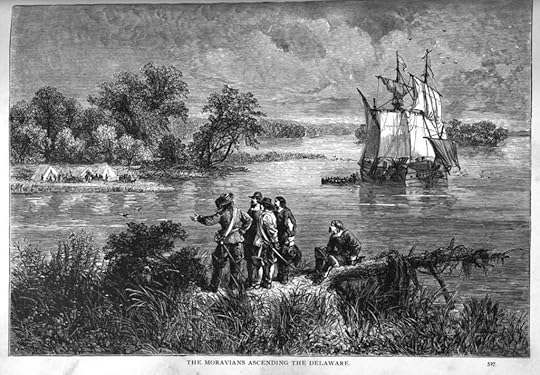David B. Williams's Blog, page 4
September 11, 2018
My beginnings as an Historian
One of the great mysteries many of us address in life is how we ended up where we are. What decisions did we make that set us down a certain path? Was it nature or nurture, luck or planning? My path toward my present life focusing on human and natural history in Seattle was one that I started very early in life.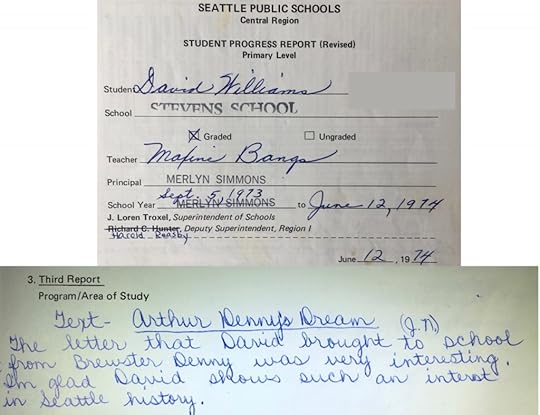
The other day, friends hosted a baby shower and requested that we bring our own baby picture. Looking through a scrap book my parents put together, I quickly found the picture I wanted but then got stuck reading through old report cards. I was able to confirm what my mom had told me when I graduated from college: “David, you never stopped talking in school.” Apparently I disturbed the other children, did not always pay attention, could be a bit too enthusiastic, and didn’t always read tests carefully. Oh well.
But then I came to my third grade report card, written by Ms. Bangs, who I remember as a gray haired, elegant and nice, older woman. I don’t remember much from the class, though I can still picture the room on the second floor of Isaac I. Stevens Elementary School.
At the time my father worked at the University of Washington and his boss was Brewster Denny, Arthur Denny’s great grandson. (I mentioned an interview with Brewster in my book, Too High and Too Steep.) According to Ms. Bangs, Brewster also wrote a letter for, or to, me. Unfortunately, I don’t have a copy. Nor is there a copy of it in his papers in Special Collections at the University of Washington.
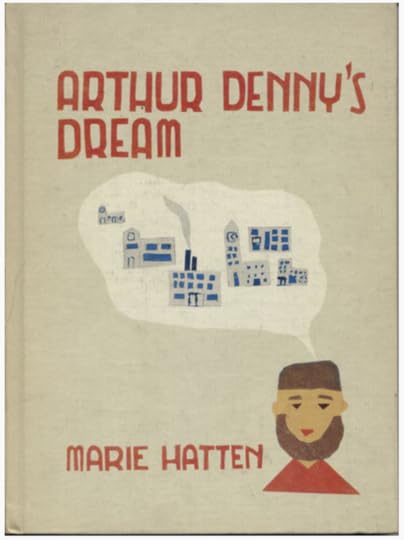 She also noted that we read Arthur Denny’s Dream, which of course I have no recollection of doing but with the power of the internet, I found a copy and bought it. The book was written in 1953 by Mrs. Marie Hatten, a fourth grade teacher at Fairview School, and illustrated by ten of her students. Using Four Wagon’s West, a book written by Arthur Denny’s granddaughter, Roberta Frye Watt, as a guide, Hatten’s students drew pictures with crayons, which they later modified with colored paper. Hatten then typed a story to go with the pictures.
She also noted that we read Arthur Denny’s Dream, which of course I have no recollection of doing but with the power of the internet, I found a copy and bought it. The book was written in 1953 by Mrs. Marie Hatten, a fourth grade teacher at Fairview School, and illustrated by ten of her students. Using Four Wagon’s West, a book written by Arthur Denny’s granddaughter, Roberta Frye Watt, as a guide, Hatten’s students drew pictures with crayons, which they later modified with colored paper. Hatten then typed a story to go with the pictures.
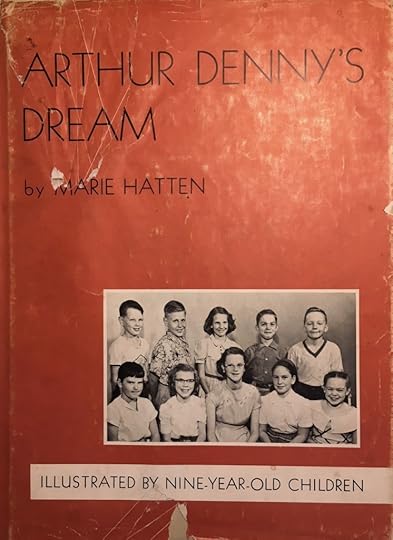 The book tells the story of Arthur, his wife Mary, and their two children, and how they traveled west by wagon. Joined by Arthur’s four bachelor brothers and several other family members, they killed a buffalo, carved their names at Independence Rock, caught fish, and had some issues with the Native inhabitants along the way. As one might imagine for a book of its era, it is racist toward the Indians that the Denny’s met enroute and in Seattle. What also stands out is the creative artwork. The illustrations depict the four brothers and the Mercer Girls.
The book tells the story of Arthur, his wife Mary, and their two children, and how they traveled west by wagon. Joined by Arthur’s four bachelor brothers and several other family members, they killed a buffalo, carved their names at Independence Rock, caught fish, and had some issues with the Native inhabitants along the way. As one might imagine for a book of its era, it is racist toward the Indians that the Denny’s met enroute and in Seattle. What also stands out is the creative artwork. The illustrations depict the four brothers and the Mercer Girls.
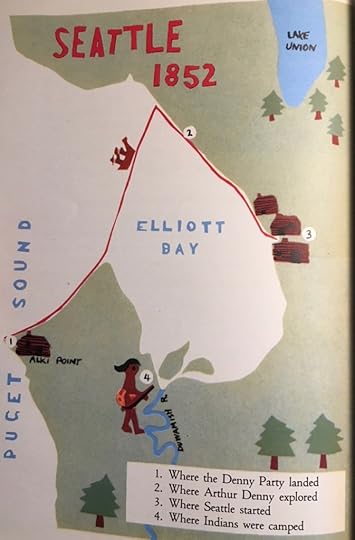
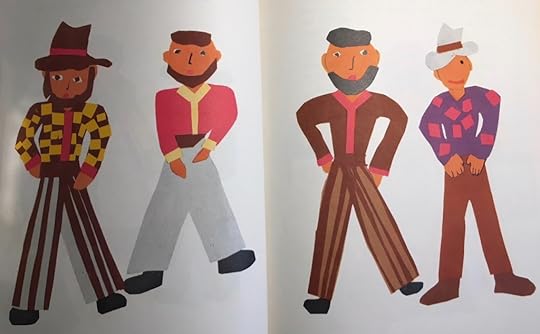
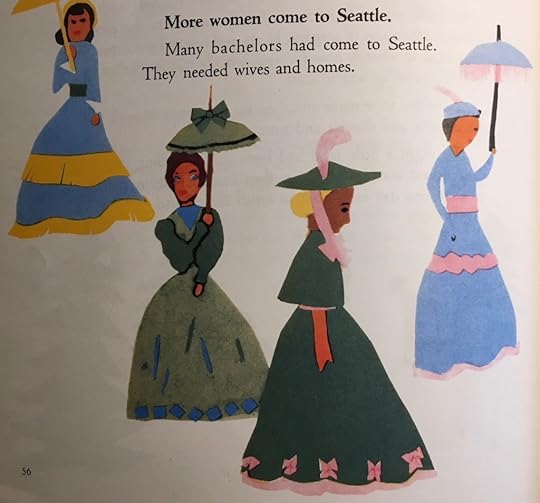 But back to my report card, where Ms. Bangs added that amazing line. “I’m glad David shows such an interest in Seattle history.” Wow, who knew that the path I now trod started so early in life. Unfortunately, Ms. Bangs died before I wrote my first book about Seattle history but I like to think she would have been proud of what her somewhat rambunctious, often distracted and distracting student became.
But back to my report card, where Ms. Bangs added that amazing line. “I’m glad David shows such an interest in Seattle history.” Wow, who knew that the path I now trod started so early in life. Unfortunately, Ms. Bangs died before I wrote my first book about Seattle history but I like to think she would have been proud of what her somewhat rambunctious, often distracted and distracting student became.
August 14, 2018
Seattle Maps 18, 19, and 20 – Magnolia Bluff
The other day I spent eight hours at Discovery Park watching the tide go out and return. It was the best experience I have had of the dramatic change that occurs in Puget Sound on a daily basis as the level of the water changes as much as 15 feet in a day. Doing this also prompted me to take a look at three maps I have that show the Magnolia peninsula.
What stands out is that each of the maps shows the low tide terrace platted with streets. It is yet another case of “what the hell were the planners thinking?” I guess they imagined building some sort of wall that would keep the tide out.
It’s also interesting to note the original platted street names changed from 1894 to 1913, followed by another small change from 1913 to 1934. I also like how in the 1913 map, West Point Avenue is planned to cut right across West Point.
Board of State Land Commissioners Map of Seattle Harbor, Surveyed Oct, Nov, Dec. 1893 and Jan. 1894 (click on each map to open a larger version)
 Seattle 1893-94
Seattle 1893-94Port of Seattle General Map of Seattle Harbor, May 1913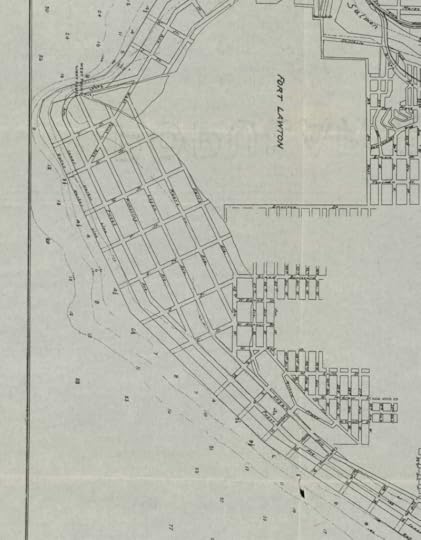
Defense Map, Location of Districts, mapped onto Map of Seattle Prepared by City Engineer’s Department, April 1934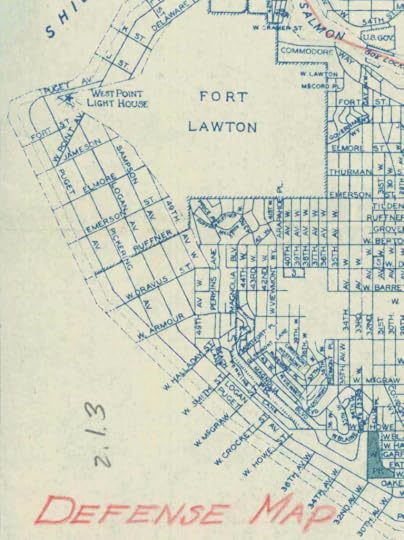
July 12, 2018
Additionally, the appointment supplies the college an opportunity to find out more about you, your passions, and also the approach you’ll be able to enhance the faculty.
Editing an essay can be a huge undertaking. Arrangement empowers the audience to comprehend wherever your essay is going and what it truly is you are attempting to permit them know. In regards to writing an essay, isn’t a tough job. Every brief article, essay, or termpaper must have the capacity to be described within a point. The very initial stage in creating a descriptive composition is actually to pick your issue. Writing an essay may be a tricky job for anyone which is just not made any easier as soon as the instructor makes an assignment and expects you to truly produce the right theme. Particularly it truly is an essential portion of the essay if you’re writing an academic article. Additionally, It makes it possible for you to produce an incredibly clear and succinct essay. Use this entire composition structure to create a detailed outline on your own essays.
Macintosh – click the apple menu and select “system preferences”.
S O your composition must be very striking. You’re set to move now, purchase the internet essay writing company on-line, settle back and relax. Therefore, the preceding ten points is a 1 stop option for the choice essay cheap problem of the largest essay writing business online if you’re going to follow them 1 by 1 you might really wind up with an ideal / brilliantly essay over time.
July 1, 2018
THE Puget Sound
The Puget Sound. Puget’s Sound. Puget Sound. What is the name of the waterway that George Vancouver designated as Puget’s Sound in his journal of May 29, 1792? As he so often does, my pal Knute Berger has found a fine little controversy to address in his fabulous history shorts on KCTS 9. Check it out. And, like Knute, I discourage the use of THE in front of Puget. THE Sound is okay but not THE Puget Sound.
June 1, 2018
West Seattle Podcast Walk 1
Recently I was interviewed by Andrew Stuckey for his Podcast: West Seattle. Our subject was my book Seattle Walks and the walks in West Seattle. Andrew ended up dividing the talk into two parts. The first one covers the infamous Pigeon Point and its “hidden bunker.”
Here’s a link. I appear eight minutes in, though I recommend listening to the entire story. Andrew did a great job of weaving the interview with a walk he took with friends.
May 11, 2018
Cairns: Radio Interview KGNU-Roger Wendell
Today, I was fortunate enough to be interviewed by Roger Wendell of Boulder’s (Colorado not Utah) KGNU community radio. Fun stuff. In case you missed it, here’s a link to it. We chatted about cairns, focusing on material from my book on those nifty little heaps of rock, or is it stone?.
April 10, 2018
Late but great news
Wow, I just discovered that Seattle Walks was the number 5 bestseller at Island Books in 2017. That’s an amazing honor. (Mostly I am simply pleased to beat out that guy named Tom Hanks.) Thank you to the store and their great support of regional authors. We are so blessed in the Seattle area to have so many astounding local independent bookstores. Let’s do all we can to support them, particularly on April 28, Independent Bookstore Day.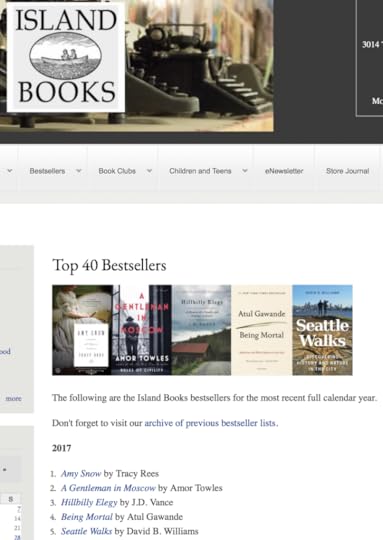
February 23, 2018
Doc Maynard, Kelp, and Potatoes
David Swinson “Doc” Maynard was one of early Seattle’s more colorful characters. In his wonderful history of Seattle, Skid Road: Seattle and Her First Hundred Years, Murray Morgan writes of Maynard: “Maynard was a man of parts, a warm human being whose worst faults grew out of his greatest virtue, his desire to be helpful; and few people ever got into more trouble trying to help others.” One of those ways in which he tried to aid others, and for which it appears he did not suffer, was in the field of potatoes.
Writing to the editor of Olympia’s Pioneer and Democrat newspaper, in November 1858 from “Alki Farm, King Co., W.T.,” which we now know of as Alki Point in Washington State, née Territory, Maynard described his new life away from the urban chaos of Seattle. “Having recently embarked in the Agricultural Ship called Farmer, I wish to see her float with the tide of prosperity and progress.” What made Maynard’s endeavor at cultivation unusual, he thought, was his use of a novel fertilizer.
The previous year he had gathered one small canoe’s worth of kelp, which he cut into small pieces and placed on his recently sowed field of spuds. When he harvested his kelp-enhanced spuds, he found a yield of 27 pounds per hill, compared with his previous year’s crop of just 4 to 5 pounds per hill. Truly astounded and pleased by his process as a potato whisperer, he sent part of his crop to the editor urging him: “Try them baked, and give me your opinion of them.”
Maynard was hardly alone in recognizing the potential of kelp. In 1913, soil scientist Frank Cameron wrote “from time immemorial sea-weeds have been recognized as having important manurial value.” Nor was Maynard the last to try to exploit kelp in Puget Sound.
 Kelp Plant at Port Stanley, from Lopez Island Historical Society
Kelp Plant at Port Stanley, from Lopez Island Historical SocietyPrior to World War I, Germany had been the world’s most important supplier of potash, which was rich in potassium. After the war began, and the supplies of potash dwindled, scientists around the country began to seek out a new source and found that few products were better than kelp, which could be burned to potash, and few places richer in kelp than Puget Sound. With a potential market of millions of dollars, six companies planned on developing kelp-to-potash plants on the waterway.
At least two plants opened. The Pacific Products Company completed a plant in Port Townsend and Western Algin Company did the same at Port Stanley on Lopez Island. Neither of them were terribly successful. When the war ended, Germany began to resupply the world with potash, and kelp was left to grow unmolested in the waters of Puget Sound.
January 19, 2018
Quote 6 – Fine Prospect That
With all the discussions of Civil War monuments, I thought I’d write up a quick little blog about two future Civil War generals. Neither need an introduction.
In 1853, Secretary of War Jefferson Davis authorized a road from Steilacoom to Walla Walla. In order to survey the road, he placed Captain George B. McClellan in charge. As early newspaper owned Thomas Prosch wrote in The Military Roads of Washington Territory, “Of this task McClellan also made an entire failure. He expended in unknown ways much of the money, but as far as the citizens and immigrants were aware not a dollar in actual road construction.”
Apparently Capt. McClellan was none too fond of the region. On November 23, 1853, he wrote his mother. “We have to pass the winter at Olympia on Puget’s Sound, a flourishing city of some 10 to 12 houses—fine prospect that…As there are no houses in Olympia, that can be had, I expect to spend the winter in a tent—labored by the rain & mud—for you must know that we don’t expect to see the sun anymore until next summer—except at rare and short intervals of time—it is raining almost constantly…I don’t think much of it [the Pacific Coast]—it is surely vastly overrated in every respect.”
November 6, 2017
Follow up to Vancouver Naming Puget Sound
Wow, turns out that my previous post about the image used by Mr. Butterworth in his book Zigzag Journeys in the Great Northwest; or, A Trip to the American Switzerland, didn’t actually show Mr. Vancouver and his men on Puget Sound. Turns out the image first appeared in The Romance and Tragedy of Pioneer Life: A Popular Account of the Heroes and Adventurers who, By Their Valor and War-craft, Beat Back the Savages from the Borders of Civilization and Gave the American Forests to the Plow and the Sickle, an appallingly racist title for a book. Written by Augustus Lynch Mason, the book came out seven years before Mr. Butterworth’s 1890 book.
Mason used the drawing, which is uncredited to an artist, in his discussion of the Moravians, a religious group that originated in Bohemia and Moravia, now part of the Czech Republic. He wrote of the persecution of the Moravians in America, which had led them around the time of the American Revolution to move to the Delaware River. As the title of the image from Mason’s book shows, it is not Mr. Vancouver in Puget Sound, but the Moravians on the Delaware.
My thanks to my pal Trileigh Tucker for pointing out this image discrepancy to me.